Climatic Structure Analysis of Olive Growing in Extremadura, Southwestern Spain
Abstract
1. Introduction
2. Materials and Methods
2.1. Study Region and Climatic Variables
2.2. Bioclimatic Indices
2.3. Analysis of the Variables
| Variables | Definition of Variables | Source |
|---|---|---|
| Tx (°C) | Average maximum temperature | AEMET [62] |
| Tn (°C) | Average minimum temperature | AEMET [62] |
| Tavg (°C) | Average temperature for the period | AEMET [62] |
| Rr (mm) | Average annual precipitation for the period | AEMET [62] |
| FD (n° day) | Number of frost days: number of days with minimum temperature below 0 °C | García-Martín et al. [75] |
| SF (n° day) | Number of severe frost days: No. of days with minimum temperature below −4.7 °C | Lodolini et al. [66] |
| AWR (mm) | Annual water requirement | (USDA) [67] |
| ETO | Potential evapotranspiration | Hargreaves method [67] |
| NDRep14.4 | Number of days at rest, with average daily temperature below 14.4 °C | López-Bernal et al. [32] |
| (n° day) | ||
| TavgRep14.4 | Average temperature of the number of days at rest | López-Bernal et al. [32] |
| (n° day) | ||
| NOGST14.4 | Number of days of active growth, with average daily temperature above 14.4 °C | Paniagua et al. [33] |
| (n° day) | ||
| TavgOGS14.4 | Average temperature of the number of days in active growth | Paniagua et al. [33] |
| (°C) | ||
| GDD14.4 | Degree days during the olive tree growth period above 14.4 °C | McMaster et al. [70] |
| (degree days) | ||
| NDCHS | Number of days with optimal temperatures for carbohydrate synthesis in leaves during the active growth period when the average daily temperature is between 20 °C and 30 °C | Tombesi et al. [61] |
| (n° day) |
3. Results and Discussion
3.1. Descriptive Analysis of Data
3.2. Extraction of Principal Component; Cluster Analysis; Description of Bioclimatic Groups
3.3. Trends of Principal Components
4. Conclusions
Author Contributions
Funding
Data Availability Statement
Acknowledgments
Conflicts of Interest
References
- Giorgi, F.; Lionello, P. Climate change projections for the Mediterranean region. Glob. Planet. Change 2008, 63, 90–104. [Google Scholar] [CrossRef]
- Braudel, F. La Mediterranée et le Monde Mediterranéena L’époque de Philippe II, 4th ed.; tome premier; Armand Colin: Paris, France, 1979. [Google Scholar]
- Böhm, J.; Antunes, M.T. A evolução da espécie olea europaea. In O Grande Livro da Oliveira e do Azeite; Dinalivro: Lisboa, Portugal, 2013; pp. 89–175. [Google Scholar]
- Di Vaio, C.; Nocerino, S.; Paduano, A.; Sacchi, R. Influence of Some Environmental Factors on Drupe Maturation and Olive Oil Composition. J. Sci. Food Agric. 2013, 93, 1134–1139. [Google Scholar] [CrossRef]
- Andrade, C.; Fonseca, A.; Santos, J.A.; Bois, B.; Jones, G.V. Historic Changes and Future Projections in Köppen–Geiger Climate Classifications in Major Wine Regions Worldwide. Climate 2024, 12, 94. [Google Scholar] [CrossRef]
- Malheiro, A.C.; Santos, J.A.; Fraga, H.; Pinto, J.G. Climate change scenarios applied to viticultural zoning in Europe. Clim. Res. 2010, 43, 163–177. [Google Scholar] [CrossRef]
- Tscholl1, S.; Candiago, S.; Marsoner, T.; Fraga, H.; Giupponi, C.; Egarter, L. Assessing the climate change vulnerability of European winegrowing regions by combining exposure, sensitivity and adaptative capacity indicators. In Proceedings of the Terclim 2022, XIVth International Terroir Congress and Climate Wine Symposium, Bordeaux, France, 3–8 July 2022. [Google Scholar]
- Honorio, F.; García-Martín, A.; Moral, F.J.; Paniagua, L.L.; Rebollo, F.J. Spanish Vineyard Classification According to Bioclimatic Indexes. Aust. J. Grape Wine Res. 2018, 24, 335–344. [Google Scholar] [CrossRef]
- Fraga, H.; Santos, J.A.; Moutinho-Pereira, J.; Carlos, C.; Silvestre, J.; Eiras-Dias, J.; Mota, T.; Malheiro, A.C. Statistical modelling of grapevine phenology in Portuguese wine regions: Observed trends and climate change projections. J. Agric. Sci. 2016, 154, 795–811. [Google Scholar] [CrossRef]
- Grillakis, M.G.; Kapetanakis, E.G.; Goumenaki, E. Climate change implications for olive flowering in Crete, Greece: Projections based on historical data. Clim. Change 2022, 175, 7. [Google Scholar] [CrossRef]
- Adão, F.; Fraga, H.; Fonseca, A.; Malheiro, A.C.; Santos, J.A. The Relationship between Land Surface Temperature and Air Temperature in the Douro Demarcated Region. Portugal. Remote Sens 2023, 15, 5373. [Google Scholar] [CrossRef]
- Fraga, H.; Guimarães, N.; Freitas, T.R.; Malheiro, A.C.; Santos, J.A. Future Scenarios for Olive Tree and Grapevine Potential Yields in the World Heritage Côa Region. Portugal. Agron. 2022, 12, 350. [Google Scholar] [CrossRef]
- Honorio, F.; Aguirado, C.; Paniagua, L.L.; García-Martín, A.; Rebollo, L.; Rebollo, F.J. Exploring the Climate and Topography of Olive Orchards in Extremadura. Southwestern Spain. Land 2024, 13, 495. [Google Scholar] [CrossRef]
- Moral, F.J.; Rebollo, F.J.; García-Martín, A.; Paniagua, L.L.; Honorio, F. Spatial and Temporal Analysis of Water Resources in the Olive-Growing Areas of Extremadura, Southwestern Spain. Land 2024, 13, 1294. [Google Scholar] [CrossRef]
- López-Bernal, Á.; Morales, A.; García-Tejera, O.; Testi, L.; Orgaz, F.; De Melo-Abreu, J.P.; Villalobos, F.J. OliveCan: A Process-Based Model of Development. Growth and Yield of Olive Orchards. Front. Plant Sci. 2018, 9, 632. [Google Scholar] [CrossRef] [PubMed]
- Masmoudi-Charfi, C.; Ben Mechlia, N. Changes in olive tree height growth during the first years of cultivation. Adv. Hortic. Sci. 2008, 22, 8–12. [Google Scholar]
- Tombesi, A.; Tombesi, S. Orchard planning and planting. In Production Techniques in Olive Growing; Publisher International Olive Council: Madrid, Spain, 2007; pp. 17–40. [Google Scholar]
- Krishna, K.R. Agroecosystems. In Soils, Climate, Crops, Nutrient Dynamics and Productivity, 1st ed.; Apple Academic Press: New York, NY, USA, 2013. [Google Scholar] [CrossRef]
- Therios, I.N. Climatic and soil conditions. In Olives: Crop Production Science in Horticulture 18; CABI Publishing: Wallingford, UK, 2009; Volume 45, pp. 51–80. [Google Scholar] [CrossRef]
- Larcher, W. Temperature stress and survival ability of Mediterranean sclerophyllous plants. Plant Biosyst. 2000, 134, 279–295. [Google Scholar] [CrossRef]
- Bartolozzi, F.; Cerquaglia, L.; Coppari, G.; Fontanazza, G. Frost tolerance induced by cold acclimation in olive (Olea europaea L.). In Proceedings of the ISHS Acta Horticulturae 586_98: IV International Symposium on Olive Growing, Valenzano, Italy, 25–30 September 2000. [Google Scholar] [CrossRef]
- Petruccelli, R.; Bartolini, G.; Ganino, T.; Zelasco, S.; Lombardo, L.; Perri, E.; Durante, M.; Bernardi, R. Cold Stress, Freezing Adaptation, Varietal Susceptibility of Olea europaea L.: A Review. Plants 2022, 11, 1367. [Google Scholar] [CrossRef] [PubMed]
- Morettini, A. Olivicoltura; Ramo Editoriale degli Agricoltori: Roma, Italy, 1972. [Google Scholar]
- Griggs, W.H.; Hartmann, H.T.; Bradley, M.V.; Iwakini, B.T.; Whisler, J. Olive Pollination in California; UC California Agricultural Experiment Station: Berkeley, CA, USA, 1975. [Google Scholar]
- Tanasijevic, L.; Todorovic, M.; Pereira, L.S.; Pizzigalli, C.; Lionello, P. Impacts of Climate Change on Olive Crop Evapotranspirationand Irrigation Requirements in the Mediterranean Region. Agric. Water Manag. 2014, 144, 54–68. [Google Scholar] [CrossRef]
- Greven, M.; Neal, S.; Green, S.; Dichio, B.; Clothier, B. The effects of drought on the water use, fruit development and oil yield from young olive trees. Agric. Water Manag. 2009, 96, 1525–1531. [Google Scholar] [CrossRef]
- Fernandes-Silva, A.A.; Ferreira, T.C.; Correia, C.M.; Malheiro, A.; Villalobos, F.J. Influence of different irrigation regimes on crop yield and water use efficiency of olive. Plant Soil. 2010, 333, 35–47. [Google Scholar] [CrossRef]
- Ponti, L.; Gutierrez, A.P.; Basso, B.; Neteler, M.; Ruti, P.M.; Dell’Aquila, A.; Iannetta, M. Olive agroecosystems in the Mediterranean Basin: Multitrophic analysis of climate effects with process-based representation of soil water balance. Procedia Environ. Sci. 2013, 19, 122–131. [Google Scholar] [CrossRef]
- Hueso, A.; Tentacoste, E.R.; Ruiz, C.; De la Rosa, J.M.; Gómez-del-Campo, M. Effect of deficit irrigation during the oil synthesis period on carbohydrate content in olive “Arbequina” hedgerows. Acta Hortic. 2018, 1199, 75–79. [Google Scholar]
- García, J.M.; Hueso, A.; Gómez-del-Campo, M. Deficit irrigation during the oil synthesis period affects olive oil quality in high-density orchards (cv. Arbequina). Agric. Water Manag. 2020, 230, 105858. [Google Scholar] [CrossRef]
- Van der Schoot, C.; Rinne, P.L. Dormancy cycling at the shoot apical meristem: Transitioning between self-organization and self-arrest. Plant Sci. 2011, 180, 120–131. [Google Scholar] [CrossRef]
- Lopez-Bernal, A.; Garcia-Tejera, O.; Testi, L.; Orgaz, F.; Villalobos, F.J. Studying and modelling winter dormancy in olive trees. Agric. For. Meteorol. 2020, 280, 107776. [Google Scholar] [CrossRef]
- Paniagua, L.L.; García-Martín, A.; Aguirado, C.; Honorio, F.; Moral, F.J.; Rebollo, F.J. Temperature trends of the olive tree cultivation period in the producing areas of Spain (1981–2019). Acta Hortic. 2023, 1372, 209–214. [Google Scholar] [CrossRef]
- Ballesteros, R.; Ortega, J.F.; Hernandez, D.; del Campo, A.; Moreno, M.A. Combined Use of Agro-Climatic and Very High-Resolution Remote Sensing Information for Crop Monitoring. Int. J. Appl. Earth Obs. Geoinf. 2018, 72, 66–75. [Google Scholar] [CrossRef]
- Pérez-López, D.; Ribas, F.; Moriana, A.; Rapoport, H.F.; De Juan, A. Influence of Temperature on the Growth and Development of Olive (Olea europaea L.) Trees. J. Hortic. Sci. Biotechnol. 2008, 83, 171–176. [Google Scholar] [CrossRef]
- Qian, B.; Zhang, X.; Chen, K.; Feng, Y.; O’Brien, T. Observed Long-Term Trends for Agroclimatic Conditions in Canada. J. Appl. Meteorol. Climatol. 2010, 49, 604–618. [Google Scholar] [CrossRef]
- Kenealy, L.; Reighard, G.; Rauh, B.; Bridges, W., Jr. Predicting Peach Maturity Dates in South Carolina with a Growing Degree Day Model. Acta Hortic. 2015, 1084, 479–752. [Google Scholar] [CrossRef]
- Asseng, S.; Ewert, F.; Martre, P.; Rötter, R.P.; Lobell, D.B.; Cammarano, D.; Kimball, B.A.; Ottman, M.J.; Wall, G.W.; White, J.W.; et al. Rising Temperatures Reduce Global Wheat Production. Nat. Clim. Change 2015, 5, 143–147. [Google Scholar] [CrossRef]
- Zhang, S.; Tao, F.; Zhang, Z. Changes in Extreme Temperatures and Their Impacts on Rice Yields in Southern China from 1981 to 2009. Field Crops Res. 2016, 189, 43–50. [Google Scholar] [CrossRef]
- Liu, Y.; Su, L.; Wang, Q.; Zhang, J.; Shan, Y.; Deng, M. Chapter Six—Comprehensive and Quantitative Analysis of Growth Characteristics of Winter Wheat in China Based on Growing Degree Days. Adv. Agric. 2020, 159, 237–273. [Google Scholar] [CrossRef]
- Anandhi, A. Growing Degree Days—Ecosystem Indicator for Changing Diurnal Temperatures and Their Impact on Corn Growth Stages in Kansas. Ecol. Indic. 2016, 61 Pt 2, 149–158. [Google Scholar] [CrossRef]
- Bonofiglio, T.; Orlandi, F.; Sgromo, C.; Romano, B.; Fornaciari, M. Influence of temperature and rainfall on timing of olive (Olea europaea) flowering in southern Italy. N. Z. J. Crop Hort. Sci. 2008, 36, 59–69. [Google Scholar] [CrossRef]
- Lombardo, L.; Fila, G.; Lombardo, N.; Epifani, C.; Duffy, D.H., III; Godino, G.; Salimonti, A.; Zelasco, S. Uncovering Olive Biodiversity through Analysis of Floral and Fruiting Biology and Assessment of Genetic Diversity of 120 Italian Cultivars with Minor or Marginal Diffusion. Biology 2019, 8, 62. [Google Scholar] [CrossRef]
- Orlandi, F.; Lanari, D.; Romano, B.; Fornaciari, M. New model to predict the timing of olive (Olea europaea) flowering: A case study in central Italy. N. Z. J. Crop Hortic. Sci. 2006, 34, 93–99. [Google Scholar] [CrossRef]
- Orlandi, F.; Avolio, E.; Bonofiglio, T.; Federico, S.; Romano, B.; Fornaciari, M. Potential shifts in olive flowering according to climate variations in Southern Italy. Meteorol. Appl. 2013, 20, 497–503. [Google Scholar] [CrossRef]
- Orlandi, F.; Vazquez, L.; Ruga, L.; Bonofiglio, T.; Fornaciari, M.; Garcia Mozo, H.; Dominquez, E.; Romano, B.; Galán, C. Bioclimatic requirements for olive flowering in two Mediterranean regions located at the same latitude (Andalucia, Spain and Sicily, Italy). Ann. Agric. Environ. Med. 2005, 12, 47–52. [Google Scholar] [PubMed]
- De Melo-Abreu, J.P.; Barranco, D.; Cordeiro, A.M.; Tous, J.; Rogado, B.M.; Villalobos, F.J. Modelling olive flowering date using chilling for dormancy release and thermal time. Agric. For. Meteorol. 2004, 125, 117–127. [Google Scholar] [CrossRef]
- Alcalá, A.R.; Barranco, D. Prediction of flowering time in olive for the Cordoba olive collection. Am. Soc. Hort Sci. 1992, 27, 1205–1207. [Google Scholar] [CrossRef]
- Hackett, W.P.; Hartmann, H.T. Inflorescence formation in olive as influenced by low temperature, photoperiod, and leaf area. Bot. Gaz. 1964, 125, 65–72. [Google Scholar]
- Aguilera, F.; Ruiz, L.; Fornaciari, M.; Romano, B.; Galán, C.; Oteros, J.; Dhiab, A.; Msallen, M.; Orlandi, F. Heat accumulation period in the Mediterranean region: Phenological response of the olive in different climate areas (Spain. Italy and Tunisia). Int. J. Biomet. 2014, 58, 867–876. [Google Scholar] [CrossRef] [PubMed]
- Hidalgo Fernandez-Cano, L.; Hidalgo Togores, J. Tratado de Viticultura, 5th ed.; Mundiprensa: Madrid, Spain, 2019; pp. 135–176. [Google Scholar]
- Jolliffe, I.T.; Cadima, J. Principal component analysis: A review and recent developments. Math. Phys. Eng. Sci. 2016, 374, 2065. [Google Scholar] [CrossRef]
- Ringnér, M. What is principal component analysis? Nat. Biotechnol. 2008, 26, 303–304. [Google Scholar] [CrossRef] [PubMed]
- Zou, H.; Hastie, T.; Tibshirani, R. Sparse principal component analysis. J. Comp. Graph. Statis. 2006, 15, 265–286. [Google Scholar] [CrossRef]
- Sistema Nacional de Cartografía de Zonas Inundables, SNCZI. Available online: https://www.miteco.gob.es/es/agua/temas/gestion-de-los-riesgos-de-inundacion/snczi.html (accessed on 29 May 2024).
- Boletín Hidrológico Nacional. Ministerio Transición Ecológica y el Reto Demográfico, MITECO. Evaluación de Los Recursos Hídricos. Available online: https://www.miteco.gob.es/es/agua/temas/evaluacion-de-los-recursos-hidricos/boletin-hidrologico.html (accessed on 29 May 2024).
- Ministerio de Agricultura Pesca y Alimentación. Anuario de Estadística. Available online: https://www.mapa.gob.es/es/estadistica/temas/publicaciones/anuario-de-estadistica/2023/default.aspx?parte=3&capitulo=07 (accessed on 29 May 2024).
- Ministerio Para la Transición Ecológica y el Reto Demográfico, MITECO. Caracterización de las Comarcas Agrarias de España. Available online: https://www.miteco.gob.es/en/ministerio/servicios/publicaciones/comarcas_agrarias-tomos.html (accessed on 17 June 2024).
- AEMET. Agencia Estatal de Meteorología (AEMET). Available online: https://www.aemet.es/es/portada (accessed on 16 February 2024).
- WMO. World Meteorological Organization Annual Report of the World Meteorological Organization 1966; WMO: Geneva, Switzerland, 1967. [Google Scholar]
- KNMI Royal Netherlands Meteorological Institute. ECAD European Climate Assessment & Dataset; Algorithm Theoretical Basis Document; Royal Netherlands Meteorological Institute KNMI: Utrecht, The Netherlands, 2013. [Google Scholar]
- Guijarro, J. Homogenization of Climatic Series with Climatol; CLIMATOL. AEMET: Balearic Islands, Spain, 2018; Available online: https://climatol.eu/ (accessed on 8 April 2024).
- Sistema de Información Sobre Ocupación del Suelo de España, SIOSE. 2014. Available online: http://www.siose.es/web/guest/descargar (accessed on 16 October 2024).
- Moral, F.J.; Rebollo, F.J.; Paniagua, L.L.; García Martín, A.; Honorio, F. Spatial distribution and comparison of aridity indices in Extremadura, Southwestern Spain. Theor. Appl. Climatol. 2016, 126, 801–814. [Google Scholar] [CrossRef]
- Lodolini, E.M.; Alfei, B.; Cioccolanti, T.; Zucchini, M.; Neri, D. Comparison of Frost Damages in Eleven Olive Cultivars after Two Freezing Events in Central Italy. Acta Hortic. 2022, 1346, 161–168. [Google Scholar] [CrossRef]
- Hargreaves, G.H.; Samani, Z.A. Reference crop evapotranspiration from temperature. Appl. Eng. Agric. 1985, 1, 96–99. [Google Scholar] [CrossRef]
- United States Department of Agriculture (USDA). National Engineering Handbook; Irrigation Guide; United States Department of Agriculture (USDA): Washington, DC, USA, 1997. Available online: https://www.nrcs.usda.gov/sites/default/files/2022-11/WA-Irrigation-Guide_4.pdf (accessed on 14 October 2024).
- Pérez-Rodríguez, J.M.; Parras, J.; Lara, E.; Prieto, M.H. Manual Práctico de Riego Olivar de Almazara; Centro de Investigaciones Científicas y Tecnológicas de Extremadura, CICYTEX (Junta de Extremadura): Badajoz, Spain, 2014; Available online: https://cicytex.juntaex.es/manuales (accessed on 27 June 2024).
- McMaster, G.S.; Wilhelm, W.W. Growing degree-days: One equation, two interpretations. Agric. For. Meteorol. 1997, 87, 291–300. [Google Scholar] [CrossRef]
- Bretherton, C.S.; Smith, C.; Wallace, J.M. An intercomparison of methods for finding coupled patterns in climate data. J. Clim. 1992, 5, 541–560. [Google Scholar] [CrossRef]
- Moral, F.J.; Rebollo, F.J.; Paniagua, L.L.; García, A.; Martínez de Salazar, E. Application of climatic indices to analyse viticultural suitability in Extremadura, South-western Spain. Theor. Appl. Climatol. 2016, 123, 277–289. [Google Scholar] [CrossRef]
- World Meteorological Organization (WMO). Guide to Hydrological Practices. Volume II—Management of Water Resources and Application of Hydrological Practices, 6th ed.; WMO-No. 168; World Meteorological Organization: Geneva, Switzerland, 2009. [Google Scholar]
- Sen, P.K. Estimates of the Regression Coefficient Based on Kendall’s Tau. J. Am. Stat. Assoc. 1968, 63, 1379–1389. [Google Scholar] [CrossRef]
- García-Martín, A.; Paniagua, L.L.; Moral, F.J.; Rebollo, F.J.; Rozas, M.A. Spatiotemporal Analysis of the Frost Regime in the Iberian Peninsula in the Context of Climate Change (1975–2018). Sustainability 2021, 13, 8491. [Google Scholar] [CrossRef]
- Ayton, J.; Mailer, R.J.; Robards, K.; Orchard, B.; Vonarx, M. Oil concentration and composition of olives during fruit maturation in south-western New South Wales. Aust. J. Exp. Agric. 2001, 41, 815–821. [Google Scholar] [CrossRef]
- Rodrigo-Comino, J.; Senciales-González, J.M.; Yu, Y.; Salvati, L.; Giménez-Morera, A.; Cerdà, A. Long-term changes in rainfed olive production, rainfall and farmer’s income in Bailén (Jaén, Spain). Euro-Mediterr. J. Environ. Integr. 2021, 6, 58. [Google Scholar] [CrossRef]
- Orlandi, F.; Bonofiglio, T.; Romano, B.; Fornaciari, M. Qualitative and quantitative aspects of olive production in relation to climate in southern Italy. Sci. Hortic. 2012, 138, 151–158. [Google Scholar] [CrossRef]
- Mousa, M.Y.; Gerasopoulos, D.; Metzidakis, I.; Kiritsakis, A. Effect of Altitude on Fruit and Oil Quality Characteristics of ‘Mastoides’ Olives. J. Sci. Food Agric. 1996, 71, 345–350. [Google Scholar] [CrossRef]
- Rongai, D.; Sabatini, N.; Del Coco, L.; Perri, E.; Del Re, P.; Simone, N.; Marchegiani, D.; Fanizzi, F.P. 1H NMR and Multivariate Analysis for Geographic Characterization of Commercial Extra Virgin Olive Oil: A Possible Correlation with Climate Data. Foods 2017, 6, 96. [Google Scholar] [CrossRef]
- Piñar-Fuentes, J.C.; Peña-Martínez, J.; Cano-Ortiz, A. Integrating Thermo-Ombroclimatic Indicators into Sustainable Olive Management: A Pathway for Innovation and Education. Agriculture 2024, 14, 2112. [Google Scholar] [CrossRef]
- Aguilera, F.; Orlandi, F.; Ruiz-Valenzuela, L.; Msallem, M.; Fornaciari, M. Analysis and interpretation of long temporal trends in cumulative temperatures and olive reproductive features using a seasonal trend decomposition procedure. Agric. For. Meteorol. 2015, 203, 208–216. [Google Scholar] [CrossRef]
- Orlandi, F.; Rojo, J.; Picornell, A.; Oteros, J.; Pérez-Badia, R.; Fornaciari, M. Impact of Climate Change on Olive Crop Production in Italy. Atmosphere 2020, 11, 595. [Google Scholar] [CrossRef]
- Fornaciari, M.; Orlandi, F.; Tedeschini, E. Long term analysis on Olive flowering and climatic relationships in central Italy. Eur. J. Agron. 2025, 162, 127435. [Google Scholar] [CrossRef]
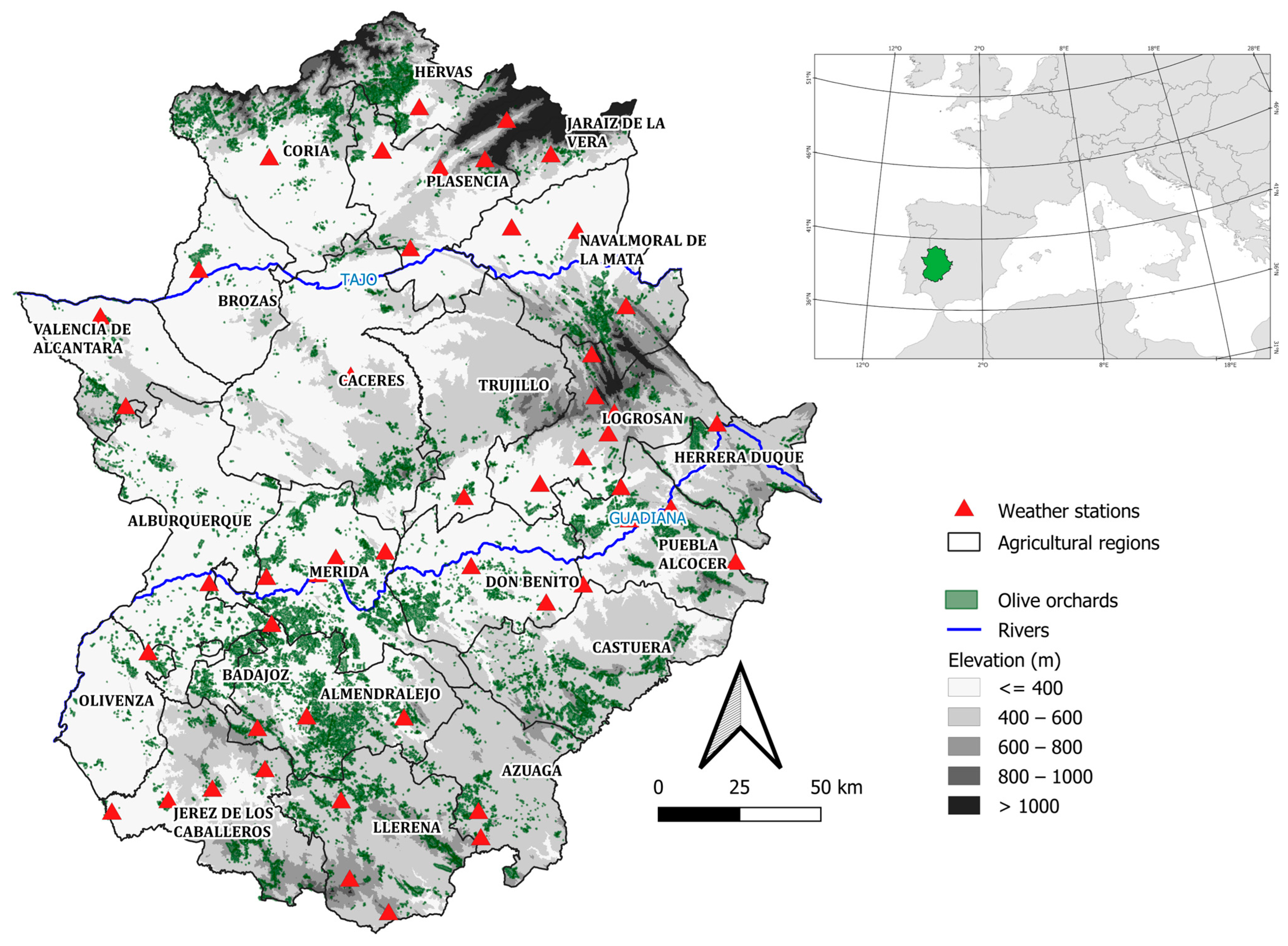
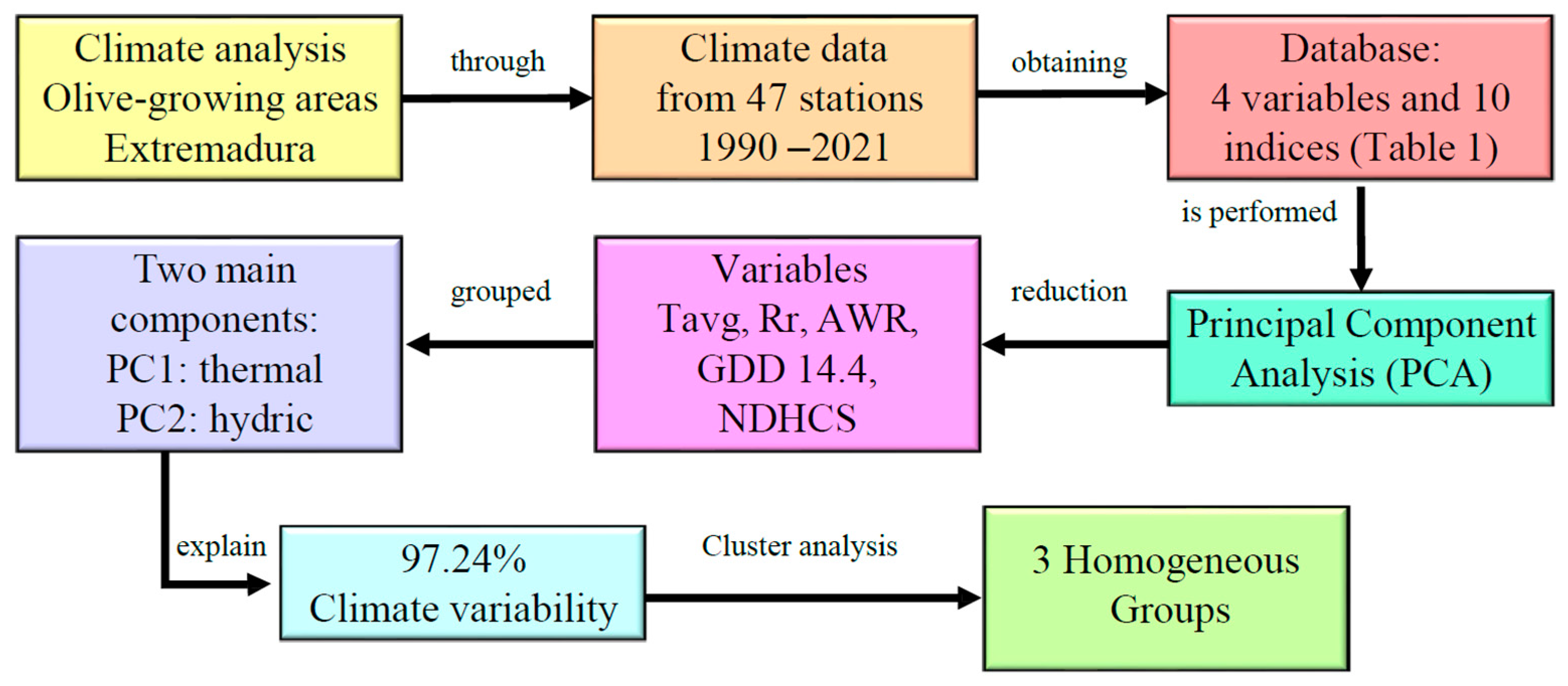
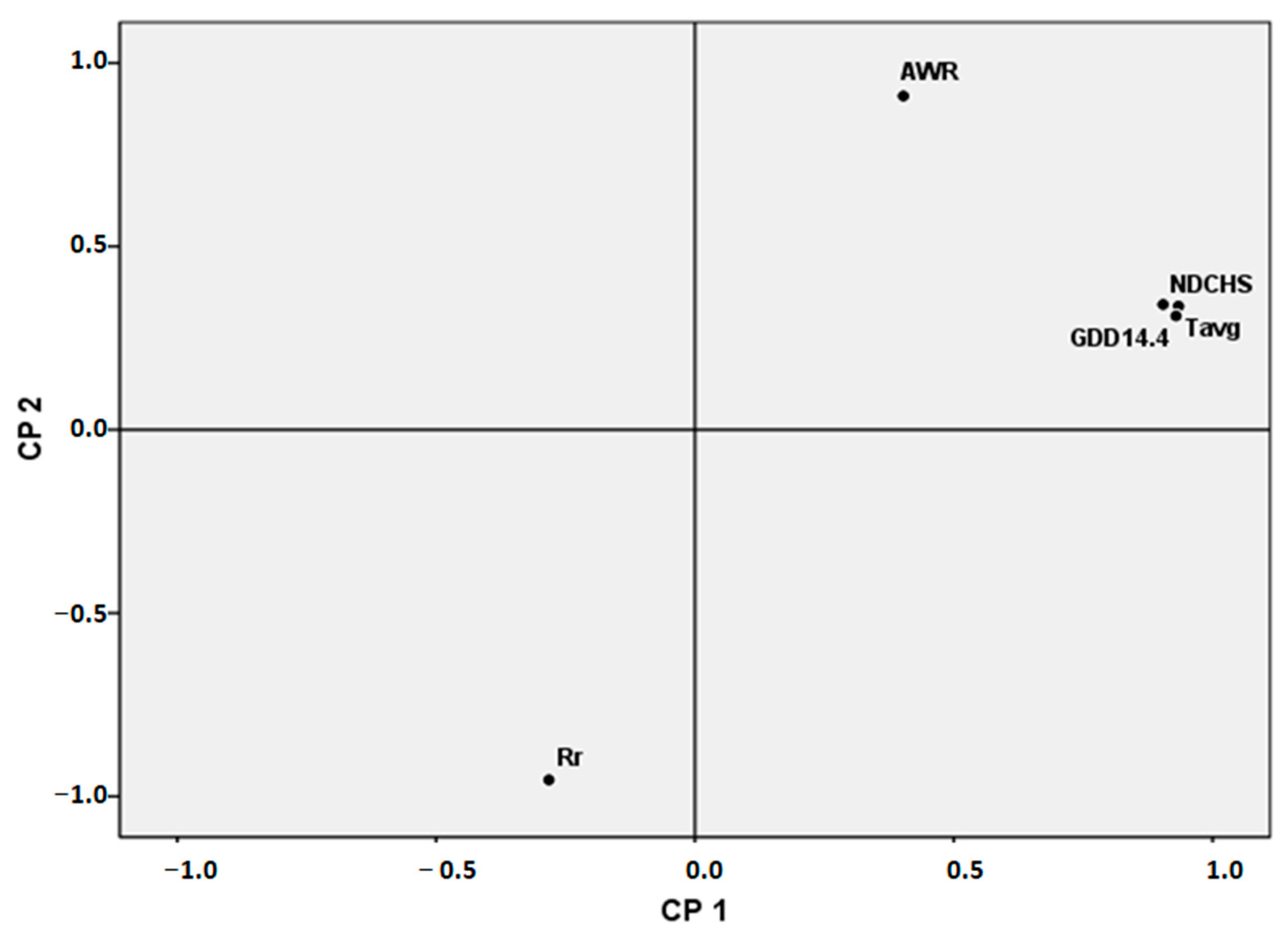

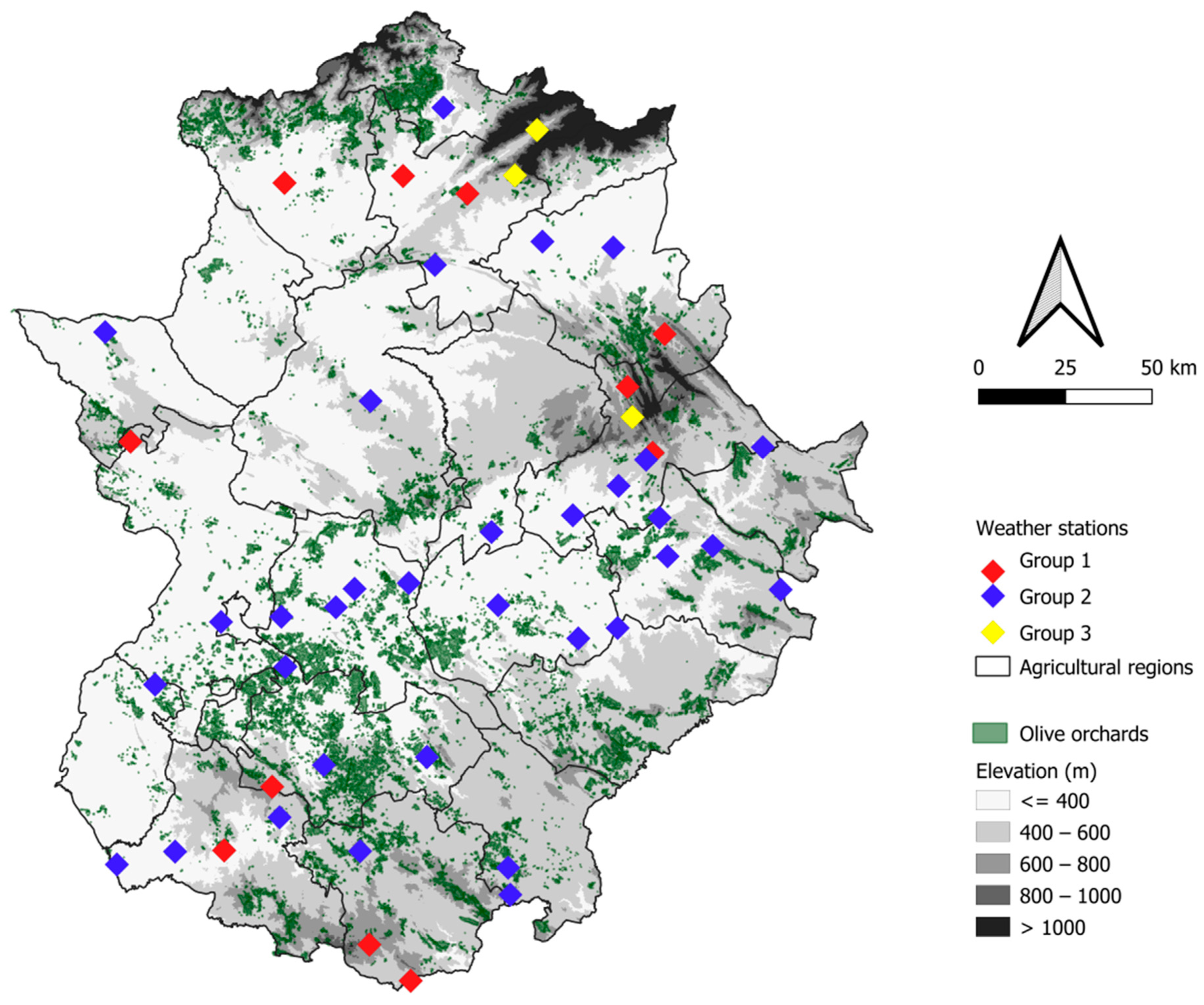
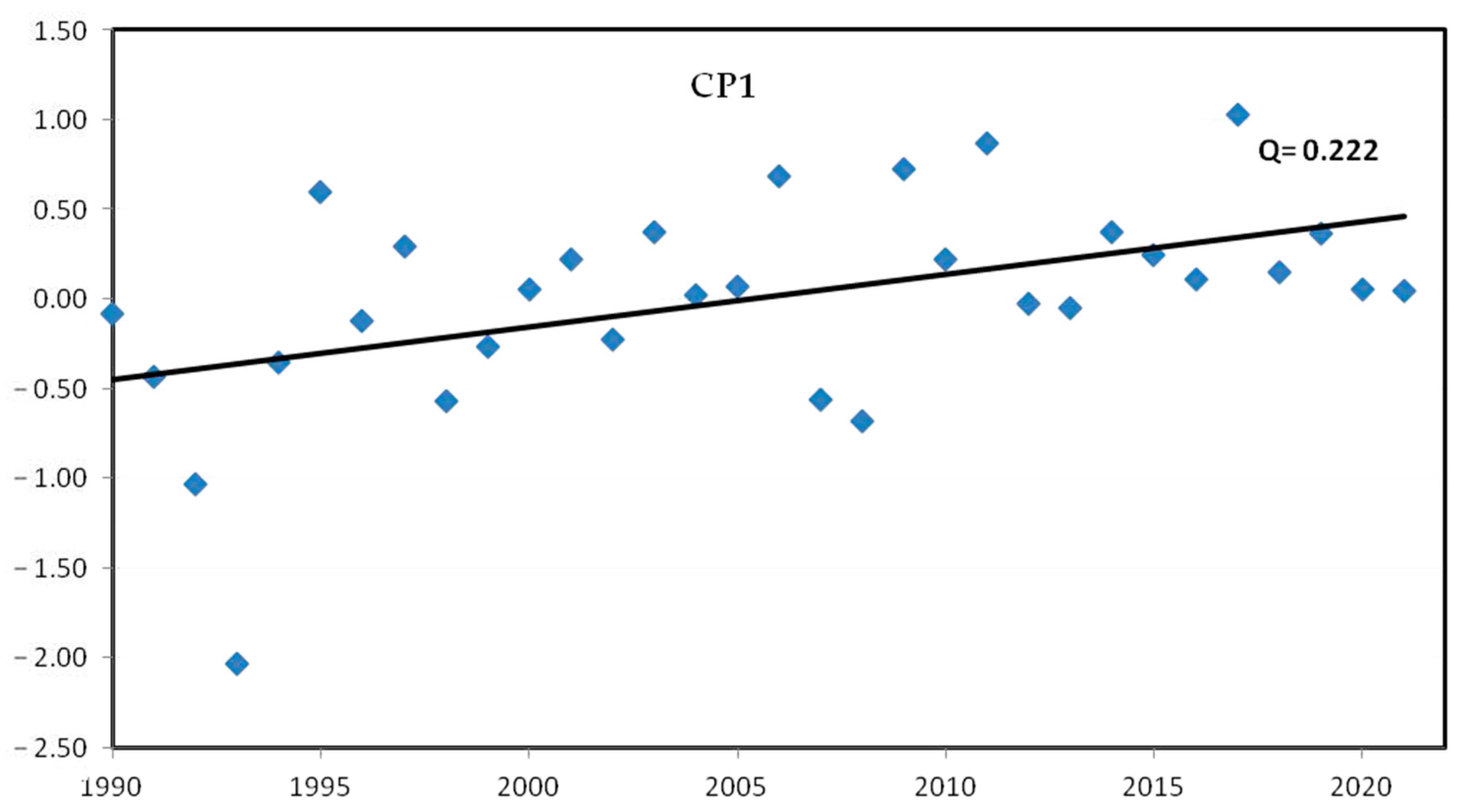
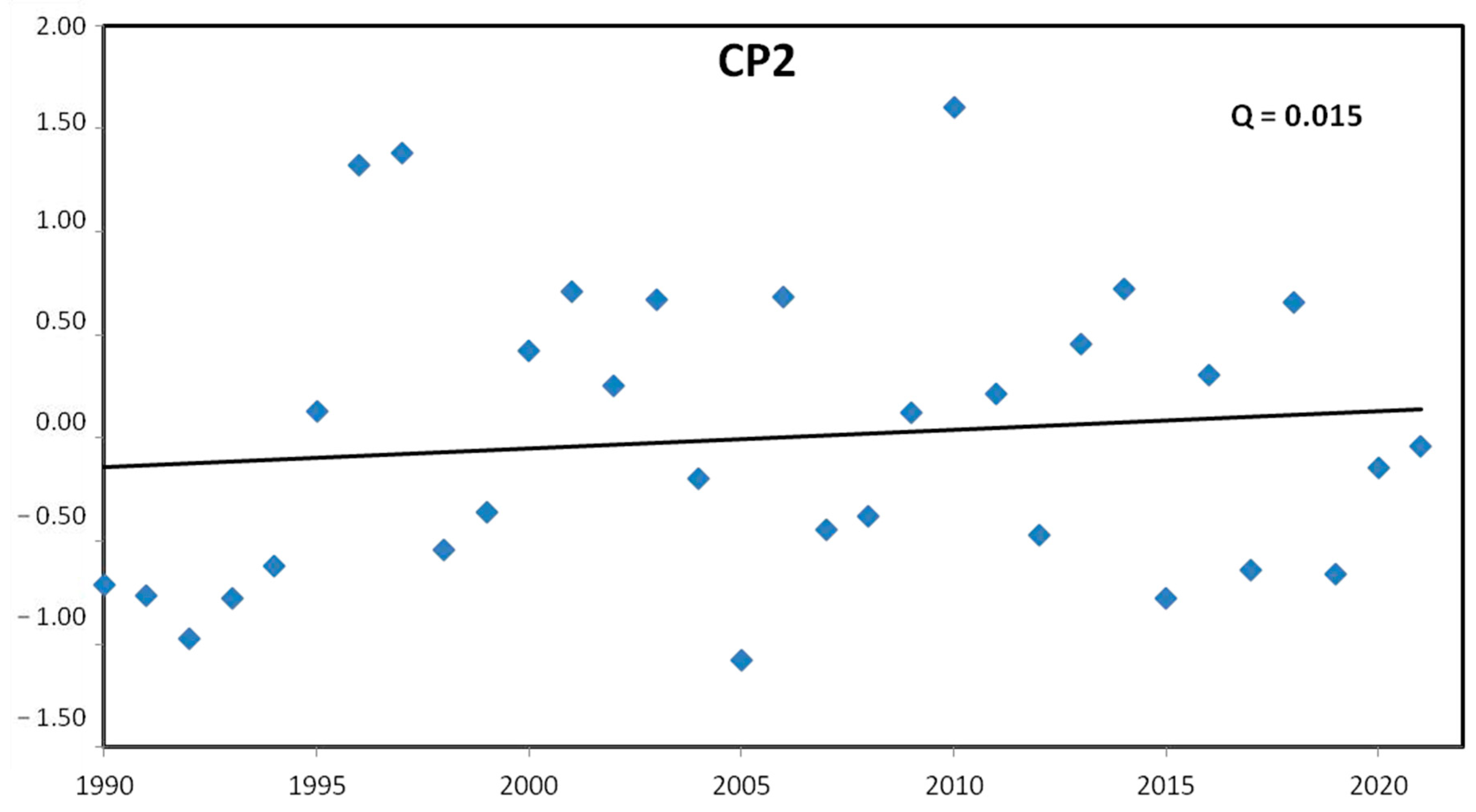
| Variable | Mean | Median | SD | Min | Max | CV (%) | Skewness | Kurtosis |
|---|---|---|---|---|---|---|---|---|
| Tn | 10.43 | 10.47 | 0.92 | 7.15 | 12.19 | 8.78 | −0.88 | 2.28 |
| Tx | 22.57 | 22.84 | 1.23 | 19.17 | 24.28 | 5.45 | −1.09 | 1.02 |
| Tavg | 16.50 | 16.68 | 0.92 | 13.26 | 17.96 | 5.55 | −1.43 | 2.63 |
| Rr | 604.23 | 556.97 | 185.19 | 389.53 | 1304.77 | 30.65 | 1.97 | 4.72 |
| FD | 15.93 | 16.06 | 9.32 | 3.44 | 48.66 | 58.48 | 1.33 | 2.66 |
| SF | 3.07 | 2.47 | 3.34 | 0.19 | 17.47 | 108.93 | 2.74 | 8.93 |
| AWR | 241.38 | 297.73 | 201.34 | −426.13 | 475.02 | 83.41 | 1.65 | 2.90 |
| ETO | 3.54 | 3.55 | 0.22 | 2.90 | 3.88 | 6.17 | −0.68 | 0.26 |
| NDRep14.4 | 162.72 | 159.00 | 15.04 | 133.97 | 210.84 | 9.24 | 1.11 | 1.52 |
| TavgRep14.4 | 9.76 | 9.89 | 0.50 | 8.29 | 11.01 | 5.13 | −0.90 | 1.67 |
| NOGST14.4 | 202.53 | 206.25 | 15.04 | 154.41 | 231.28 | 7.43 | −1.11 | 1.52 |
| TavgOGS14.4 | 21.94 | 21.97 | 0.49 | 20.08 | 22.87 | 2.22 | −1.06 | 3.47 |
| GDD14.4 | 1529.67 | 1564.15 | 188.51 | 870.98 | 1808.54 | 12.32 | −1.19 | 2.14 |
| NDCHS | 112.22 | 113.69 | 10.48 | 70.81 | 130.66 | 9.34 | −1.65 | 4.63 |
| Index | Tavg | Rr | AWR | GDD14.4 | NDCHS |
|---|---|---|---|---|---|
| Tavg | 1 | ||||
| Rr | −0.587 ** | 1 | |||
| AWR | 0.681 ** | −0.974 ** | 1 | ||
| GDD14.4 | 0.976 ** | −0.562 ** | 0.655 ** | 1 | |
| NDCHS | 0.942 ** | −0.577 ** | 0.677 ** | 0.901 ** | 1 |
| Principal Component | Eigenvalue | Component Loading | Cumulative Loading | ||
|---|---|---|---|---|---|
| PC1 | 4.02 | 80.42 | 80.42 | ||
| PC2 | 0.84 | 16.82 | 97.24 | ||
| PC3 | 0.10 | 2.07 | 99.31 | ||
| PC4 | 0.02 | 0.37 | 99.68 | ||
| PC5 | 0.02 | 0.32 | 100.00 | ||
| PC loadings for each variable | |||||
| Tavg | Rr | AWR | GDD14.4 | NDCHS | |
| PC1 | 0.934 | −0.282 | 0.402 | 0.929 | 0.904 |
| PC2 | 0.337 | −0.955 | 0.910 | 0.310 | 0.342 |
| Group | Elevation | Tavg | Rr | ||||||
|---|---|---|---|---|---|---|---|---|---|
| Mean | Min | Max | Mean | Min | Max | Mean | Min | Max | |
| G1 | 526.0 ab | 261.0 | 750.0 | 15.7 a | 14.6 | 16.6 | 694.4 a | 555.08 | 908.7 |
| G2 | 365.7 a | 185.0 | 573.0 | 16.9 b | 16.1 | 18.0 | 524.3 b | 389.5 | 730.5 |
| G3 | 680.0 b | 515.0 | 796.0 | 14.8 c | 13.2 | 16.2 | 1153.0 c | 1006.7 | 1304.8 |
| Group | GDD14.4 | NDCHS | AWR | ||||||
| Mean | Min | Max | Mean | Min | Max | Mean | Min | Max | |
| G1 | 1339.7 a | 1156.8 | 1489.5 | 103.5 a | 90.3 | 113.7 | 114.4 a | −104.3 | 274.7 |
| G2 | 1623.2 b | 1455.5 | 1808.5 | 116.9 b | 106.9 | 130.7 | 335.6 b | 106.8 | 475.0 |
| G3 | 1197.5 a | 8701.0 | 1464.5 | 93.0 c | 70.8 | 111.0 | −329.5 c | −426.1 | −209.7 |
| Principal | Mann–Kendall Trend | Sen’s Slope Estimate | |
|---|---|---|---|
| Component | Test Z | Signific. | Q |
| PC1 | 2.51 | ** | 0.222 |
| PC2 | 0.89 | 0.015 |
Disclaimer/Publisher’s Note: The statements, opinions and data contained in all publications are solely those of the individual author(s) and contributor(s) and not of MDPI and/or the editor(s). MDPI and/or the editor(s) disclaim responsibility for any injury to people or property resulting from any ideas, methods, instructions or products referred to in the content. |
© 2025 by the authors. Licensee MDPI, Basel, Switzerland. This article is an open access article distributed under the terms and conditions of the Creative Commons Attribution (CC BY) license (https://creativecommons.org/licenses/by/4.0/).
Share and Cite
Honorio, F.; García-Martín, A.; Aguirado, C.; Paniagua, L.L. Climatic Structure Analysis of Olive Growing in Extremadura, Southwestern Spain. Land 2025, 14, 789. https://doi.org/10.3390/land14040789
Honorio F, García-Martín A, Aguirado C, Paniagua LL. Climatic Structure Analysis of Olive Growing in Extremadura, Southwestern Spain. Land. 2025; 14(4):789. https://doi.org/10.3390/land14040789
Chicago/Turabian StyleHonorio, Fulgencio, Abelardo García-Martín, Cristina Aguirado, and Luis L. Paniagua. 2025. "Climatic Structure Analysis of Olive Growing in Extremadura, Southwestern Spain" Land 14, no. 4: 789. https://doi.org/10.3390/land14040789
APA StyleHonorio, F., García-Martín, A., Aguirado, C., & Paniagua, L. L. (2025). Climatic Structure Analysis of Olive Growing in Extremadura, Southwestern Spain. Land, 14(4), 789. https://doi.org/10.3390/land14040789







